Oil Search Limited Annual Report Analysis - HA3011 Advanced Accounting
VerifiedAdded on 2023/03/21
|15
|3626
|54
Report
AI Summary
This report provides a detailed analysis of Oil Search Limited's 2017 annual report, focusing on key accounting concepts such as accrual, consistency, going-concern, and prudence, with examples from the report. It discusses the conceptual framework (CF) and debates surrounding measurement in accounting, particularly the transition to fair value from historical cost. The report also examines the relevance and representational faithfulness of financial information, assessing their importance in accounting for assets and liabilities, using Oil Search Limited as a case study. The analysis incorporates IFRS standards and academic literature to provide a comprehensive understanding of the company's financial reporting practices. Desklib offers additional resources and solved assignments for students.
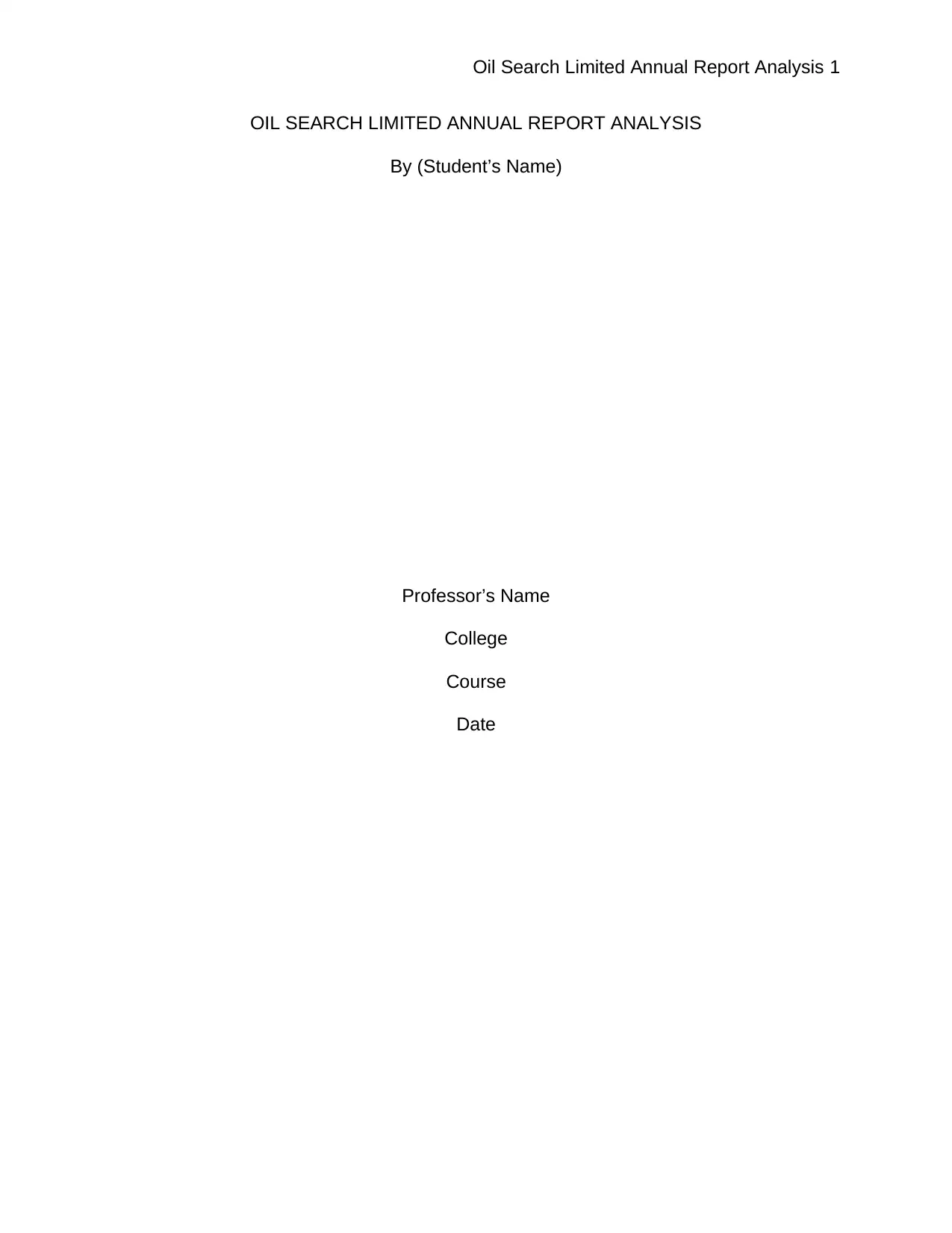
Oil Search Limited Annual Report Analysis 1
OIL SEARCH LIMITED ANNUAL REPORT ANALYSIS
By (Student’s Name)
Professor’s Name
College
Course
Date
OIL SEARCH LIMITED ANNUAL REPORT ANALYSIS
By (Student’s Name)
Professor’s Name
College
Course
Date
Paraphrase This Document
Need a fresh take? Get an instant paraphrase of this document with our AI Paraphraser
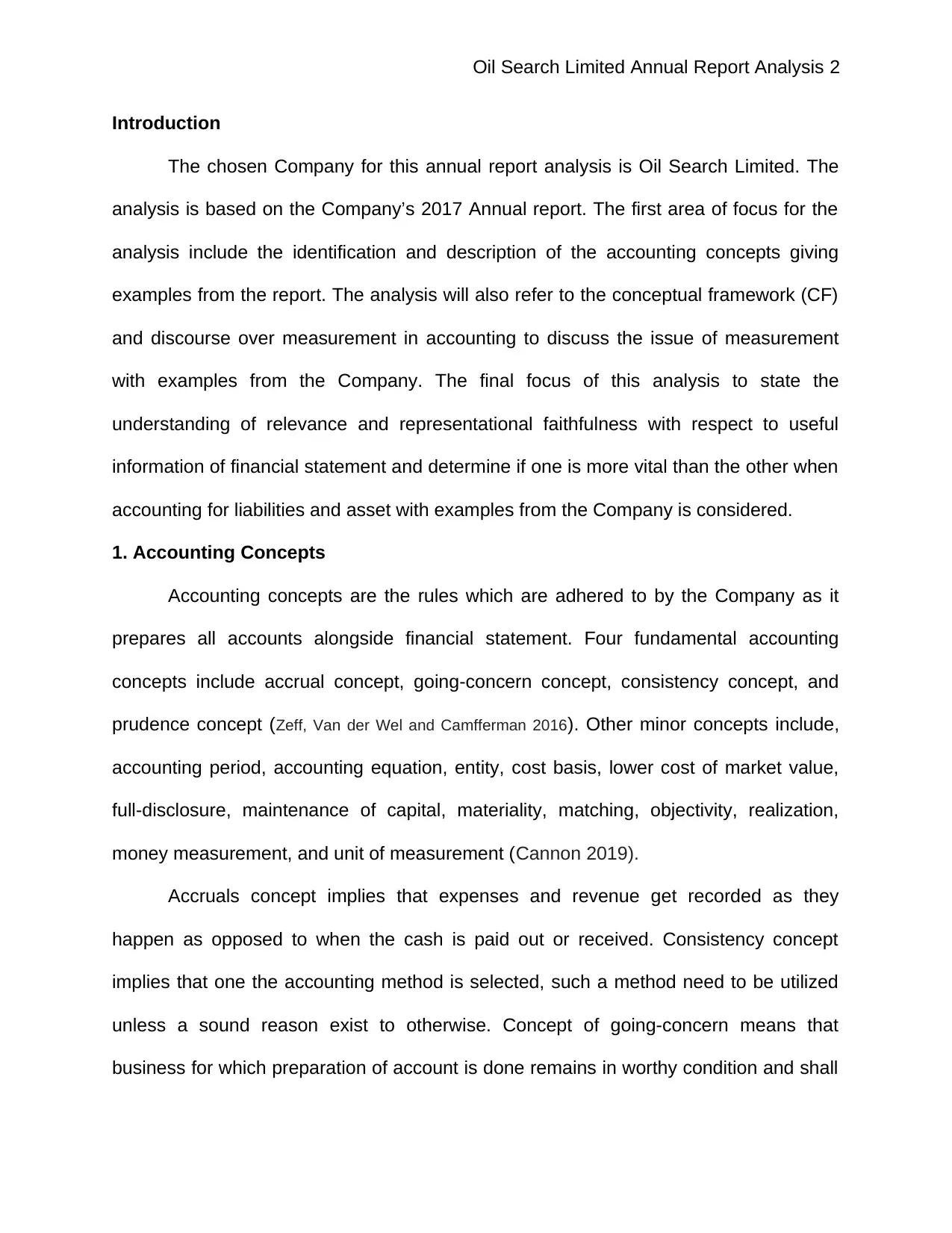
Oil Search Limited Annual Report Analysis 2
Introduction
The chosen Company for this annual report analysis is Oil Search Limited. The
analysis is based on the Company’s 2017 Annual report. The first area of focus for the
analysis include the identification and description of the accounting concepts giving
examples from the report. The analysis will also refer to the conceptual framework (CF)
and discourse over measurement in accounting to discuss the issue of measurement
with examples from the Company. The final focus of this analysis to state the
understanding of relevance and representational faithfulness with respect to useful
information of financial statement and determine if one is more vital than the other when
accounting for liabilities and asset with examples from the Company is considered.
1. Accounting Concepts
Accounting concepts are the rules which are adhered to by the Company as it
prepares all accounts alongside financial statement. Four fundamental accounting
concepts include accrual concept, going-concern concept, consistency concept, and
prudence concept (Zeff, Van der Wel and Camfferman 2016). Other minor concepts include,
accounting period, accounting equation, entity, cost basis, lower cost of market value,
full-disclosure, maintenance of capital, materiality, matching, objectivity, realization,
money measurement, and unit of measurement (Cannon 2019).
Accruals concept implies that expenses and revenue get recorded as they
happen as opposed to when the cash is paid out or received. Consistency concept
implies that one the accounting method is selected, such a method need to be utilized
unless a sound reason exist to otherwise. Concept of going-concern means that
business for which preparation of account is done remains in worthy condition and shall
Introduction
The chosen Company for this annual report analysis is Oil Search Limited. The
analysis is based on the Company’s 2017 Annual report. The first area of focus for the
analysis include the identification and description of the accounting concepts giving
examples from the report. The analysis will also refer to the conceptual framework (CF)
and discourse over measurement in accounting to discuss the issue of measurement
with examples from the Company. The final focus of this analysis to state the
understanding of relevance and representational faithfulness with respect to useful
information of financial statement and determine if one is more vital than the other when
accounting for liabilities and asset with examples from the Company is considered.
1. Accounting Concepts
Accounting concepts are the rules which are adhered to by the Company as it
prepares all accounts alongside financial statement. Four fundamental accounting
concepts include accrual concept, going-concern concept, consistency concept, and
prudence concept (Zeff, Van der Wel and Camfferman 2016). Other minor concepts include,
accounting period, accounting equation, entity, cost basis, lower cost of market value,
full-disclosure, maintenance of capital, materiality, matching, objectivity, realization,
money measurement, and unit of measurement (Cannon 2019).
Accruals concept implies that expenses and revenue get recorded as they
happen as opposed to when the cash is paid out or received. Consistency concept
implies that one the accounting method is selected, such a method need to be utilized
unless a sound reason exist to otherwise. Concept of going-concern means that
business for which preparation of account is done remains in worthy condition and shall
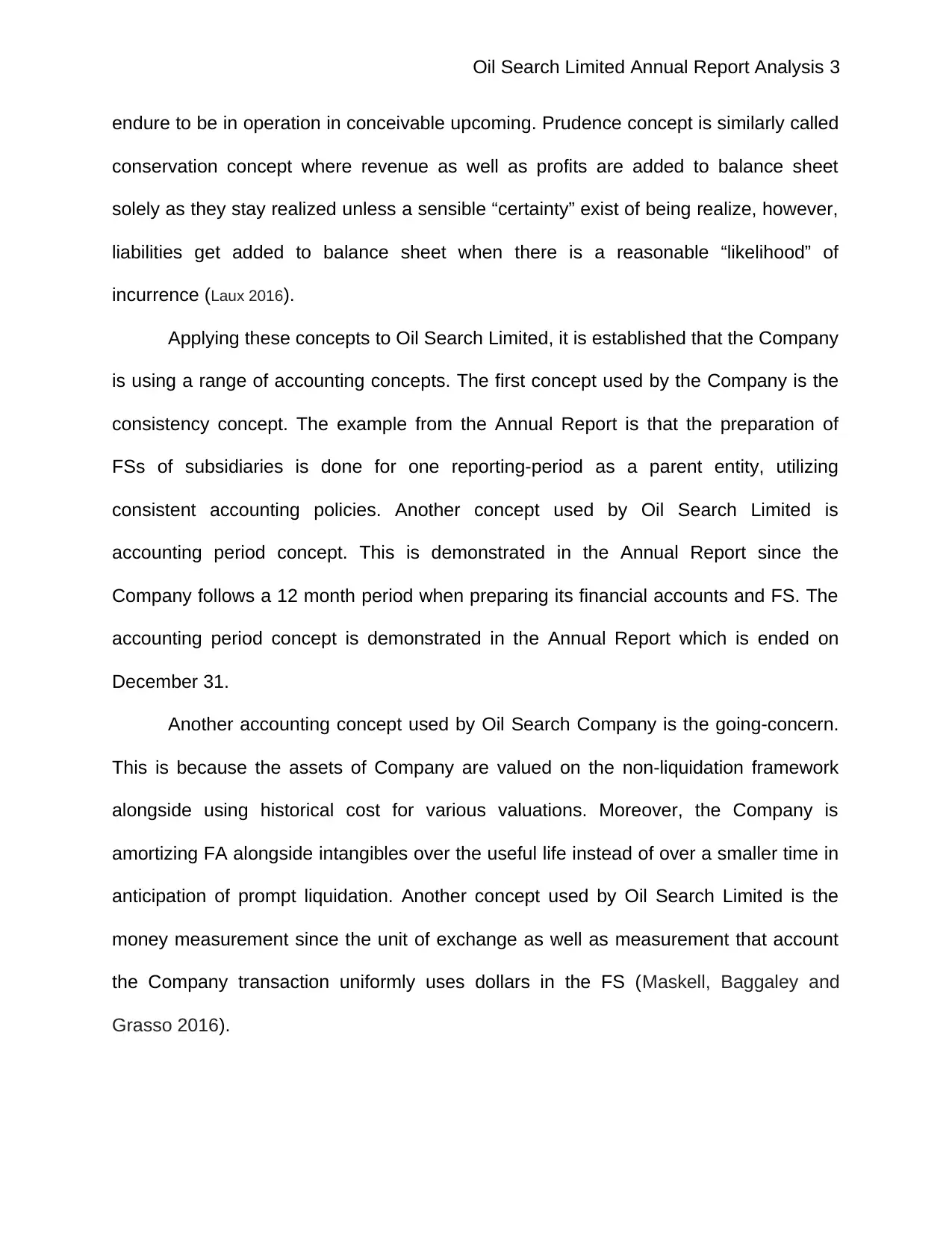
Oil Search Limited Annual Report Analysis 3
endure to be in operation in conceivable upcoming. Prudence concept is similarly called
conservation concept where revenue as well as profits are added to balance sheet
solely as they stay realized unless a sensible “certainty” exist of being realize, however,
liabilities get added to balance sheet when there is a reasonable “likelihood” of
incurrence (Laux 2016).
Applying these concepts to Oil Search Limited, it is established that the Company
is using a range of accounting concepts. The first concept used by the Company is the
consistency concept. The example from the Annual Report is that the preparation of
FSs of subsidiaries is done for one reporting-period as a parent entity, utilizing
consistent accounting policies. Another concept used by Oil Search Limited is
accounting period concept. This is demonstrated in the Annual Report since the
Company follows a 12 month period when preparing its financial accounts and FS. The
accounting period concept is demonstrated in the Annual Report which is ended on
December 31.
Another accounting concept used by Oil Search Company is the going-concern.
This is because the assets of Company are valued on the non-liquidation framework
alongside using historical cost for various valuations. Moreover, the Company is
amortizing FA alongside intangibles over the useful life instead of over a smaller time in
anticipation of prompt liquidation. Another concept used by Oil Search Limited is the
money measurement since the unit of exchange as well as measurement that account
the Company transaction uniformly uses dollars in the FS (Maskell, Baggaley and
Grasso 2016).
endure to be in operation in conceivable upcoming. Prudence concept is similarly called
conservation concept where revenue as well as profits are added to balance sheet
solely as they stay realized unless a sensible “certainty” exist of being realize, however,
liabilities get added to balance sheet when there is a reasonable “likelihood” of
incurrence (Laux 2016).
Applying these concepts to Oil Search Limited, it is established that the Company
is using a range of accounting concepts. The first concept used by the Company is the
consistency concept. The example from the Annual Report is that the preparation of
FSs of subsidiaries is done for one reporting-period as a parent entity, utilizing
consistent accounting policies. Another concept used by Oil Search Limited is
accounting period concept. This is demonstrated in the Annual Report since the
Company follows a 12 month period when preparing its financial accounts and FS. The
accounting period concept is demonstrated in the Annual Report which is ended on
December 31.
Another accounting concept used by Oil Search Company is the going-concern.
This is because the assets of Company are valued on the non-liquidation framework
alongside using historical cost for various valuations. Moreover, the Company is
amortizing FA alongside intangibles over the useful life instead of over a smaller time in
anticipation of prompt liquidation. Another concept used by Oil Search Limited is the
money measurement since the unit of exchange as well as measurement that account
the Company transaction uniformly uses dollars in the FS (Maskell, Baggaley and
Grasso 2016).
⊘ This is a preview!⊘
Do you want full access?
Subscribe today to unlock all pages.

Trusted by 1+ million students worldwide
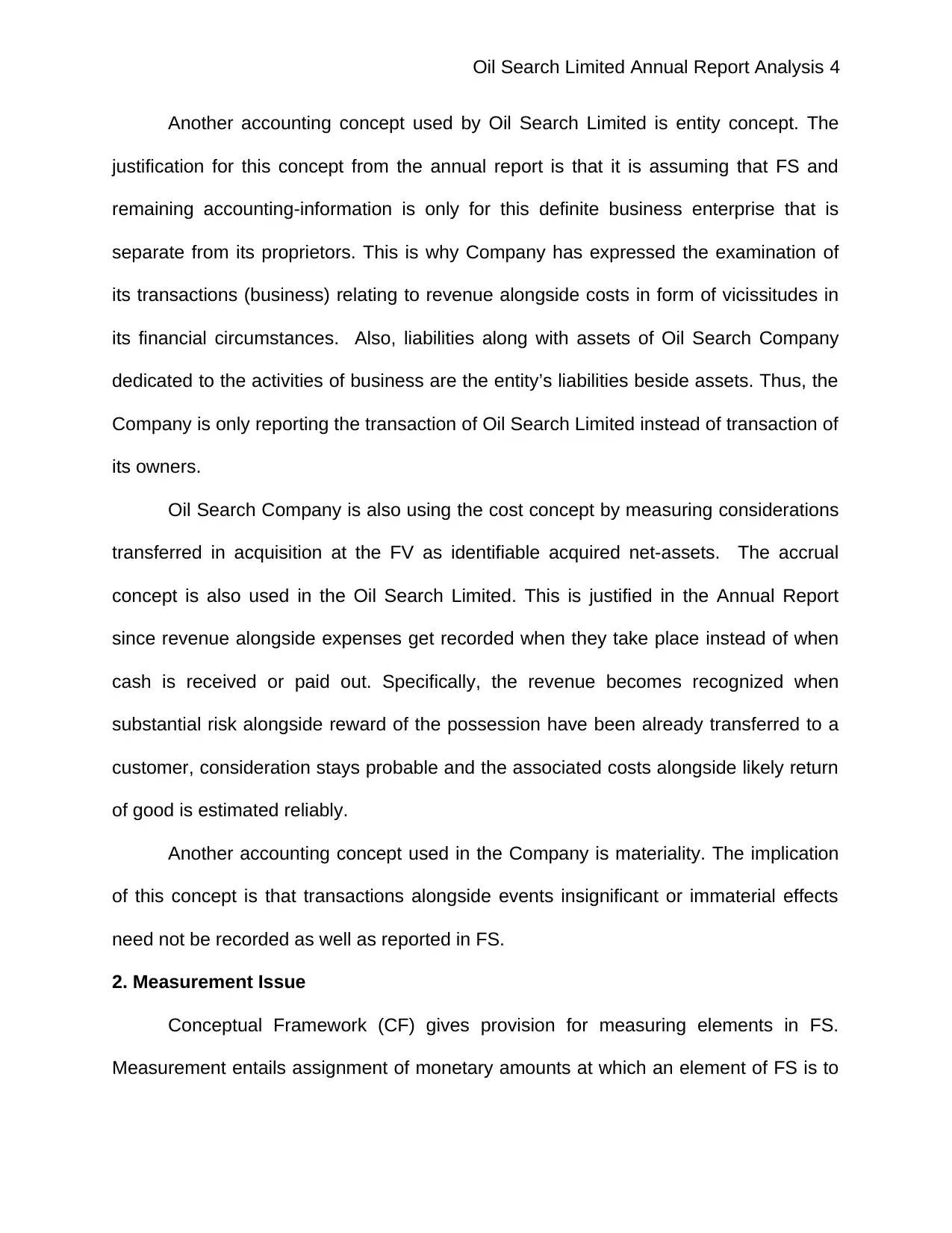
Oil Search Limited Annual Report Analysis 4
Another accounting concept used by Oil Search Limited is entity concept. The
justification for this concept from the annual report is that it is assuming that FS and
remaining accounting-information is only for this definite business enterprise that is
separate from its proprietors. This is why Company has expressed the examination of
its transactions (business) relating to revenue alongside costs in form of vicissitudes in
its financial circumstances. Also, liabilities along with assets of Oil Search Company
dedicated to the activities of business are the entity’s liabilities beside assets. Thus, the
Company is only reporting the transaction of Oil Search Limited instead of transaction of
its owners.
Oil Search Company is also using the cost concept by measuring considerations
transferred in acquisition at the FV as identifiable acquired net-assets. The accrual
concept is also used in the Oil Search Limited. This is justified in the Annual Report
since revenue alongside expenses get recorded when they take place instead of when
cash is received or paid out. Specifically, the revenue becomes recognized when
substantial risk alongside reward of the possession have been already transferred to a
customer, consideration stays probable and the associated costs alongside likely return
of good is estimated reliably.
Another accounting concept used in the Company is materiality. The implication
of this concept is that transactions alongside events insignificant or immaterial effects
need not be recorded as well as reported in FS.
2. Measurement Issue
Conceptual Framework (CF) gives provision for measuring elements in FS.
Measurement entails assignment of monetary amounts at which an element of FS is to
Another accounting concept used by Oil Search Limited is entity concept. The
justification for this concept from the annual report is that it is assuming that FS and
remaining accounting-information is only for this definite business enterprise that is
separate from its proprietors. This is why Company has expressed the examination of
its transactions (business) relating to revenue alongside costs in form of vicissitudes in
its financial circumstances. Also, liabilities along with assets of Oil Search Company
dedicated to the activities of business are the entity’s liabilities beside assets. Thus, the
Company is only reporting the transaction of Oil Search Limited instead of transaction of
its owners.
Oil Search Company is also using the cost concept by measuring considerations
transferred in acquisition at the FV as identifiable acquired net-assets. The accrual
concept is also used in the Oil Search Limited. This is justified in the Annual Report
since revenue alongside expenses get recorded when they take place instead of when
cash is received or paid out. Specifically, the revenue becomes recognized when
substantial risk alongside reward of the possession have been already transferred to a
customer, consideration stays probable and the associated costs alongside likely return
of good is estimated reliably.
Another accounting concept used in the Company is materiality. The implication
of this concept is that transactions alongside events insignificant or immaterial effects
need not be recorded as well as reported in FS.
2. Measurement Issue
Conceptual Framework (CF) gives provision for measuring elements in FS.
Measurement entails assignment of monetary amounts at which an element of FS is to
Paraphrase This Document
Need a fresh take? Get an instant paraphrase of this document with our AI Paraphraser
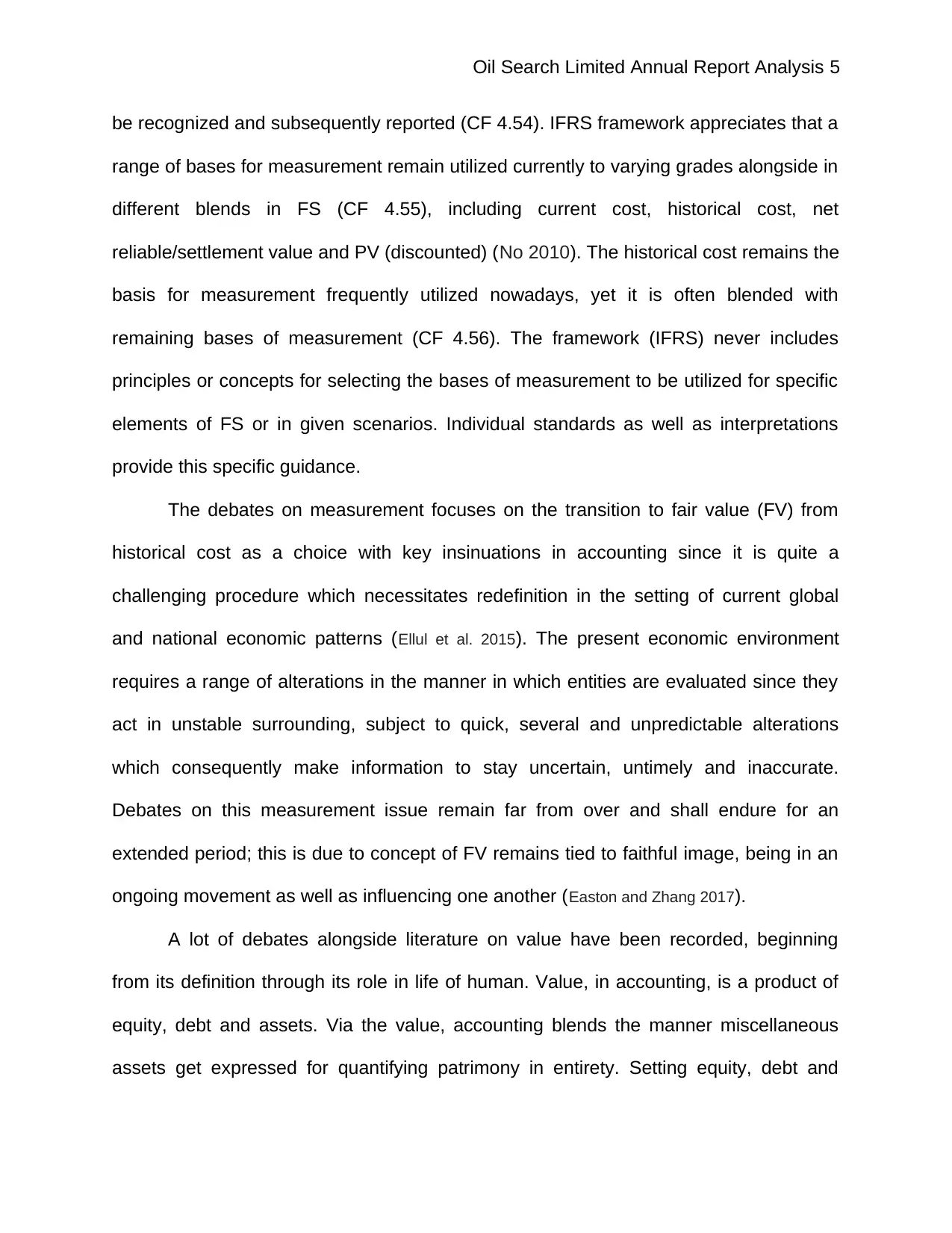
Oil Search Limited Annual Report Analysis 5
be recognized and subsequently reported (CF 4.54). IFRS framework appreciates that a
range of bases for measurement remain utilized currently to varying grades alongside in
different blends in FS (CF 4.55), including current cost, historical cost, net
reliable/settlement value and PV (discounted) (No 2010). The historical cost remains the
basis for measurement frequently utilized nowadays, yet it is often blended with
remaining bases of measurement (CF 4.56). The framework (IFRS) never includes
principles or concepts for selecting the bases of measurement to be utilized for specific
elements of FS or in given scenarios. Individual standards as well as interpretations
provide this specific guidance.
The debates on measurement focuses on the transition to fair value (FV) from
historical cost as a choice with key insinuations in accounting since it is quite a
challenging procedure which necessitates redefinition in the setting of current global
and national economic patterns (Ellul et al. 2015). The present economic environment
requires a range of alterations in the manner in which entities are evaluated since they
act in unstable surrounding, subject to quick, several and unpredictable alterations
which consequently make information to stay uncertain, untimely and inaccurate.
Debates on this measurement issue remain far from over and shall endure for an
extended period; this is due to concept of FV remains tied to faithful image, being in an
ongoing movement as well as influencing one another (Easton and Zhang 2017).
A lot of debates alongside literature on value have been recorded, beginning
from its definition through its role in life of human. Value, in accounting, is a product of
equity, debt and assets. Via the value, accounting blends the manner miscellaneous
assets get expressed for quantifying patrimony in entirety. Setting equity, debt and
be recognized and subsequently reported (CF 4.54). IFRS framework appreciates that a
range of bases for measurement remain utilized currently to varying grades alongside in
different blends in FS (CF 4.55), including current cost, historical cost, net
reliable/settlement value and PV (discounted) (No 2010). The historical cost remains the
basis for measurement frequently utilized nowadays, yet it is often blended with
remaining bases of measurement (CF 4.56). The framework (IFRS) never includes
principles or concepts for selecting the bases of measurement to be utilized for specific
elements of FS or in given scenarios. Individual standards as well as interpretations
provide this specific guidance.
The debates on measurement focuses on the transition to fair value (FV) from
historical cost as a choice with key insinuations in accounting since it is quite a
challenging procedure which necessitates redefinition in the setting of current global
and national economic patterns (Ellul et al. 2015). The present economic environment
requires a range of alterations in the manner in which entities are evaluated since they
act in unstable surrounding, subject to quick, several and unpredictable alterations
which consequently make information to stay uncertain, untimely and inaccurate.
Debates on this measurement issue remain far from over and shall endure for an
extended period; this is due to concept of FV remains tied to faithful image, being in an
ongoing movement as well as influencing one another (Easton and Zhang 2017).
A lot of debates alongside literature on value have been recorded, beginning
from its definition through its role in life of human. Value, in accounting, is a product of
equity, debt and assets. Via the value, accounting blends the manner miscellaneous
assets get expressed for quantifying patrimony in entirety. Setting equity, debt and
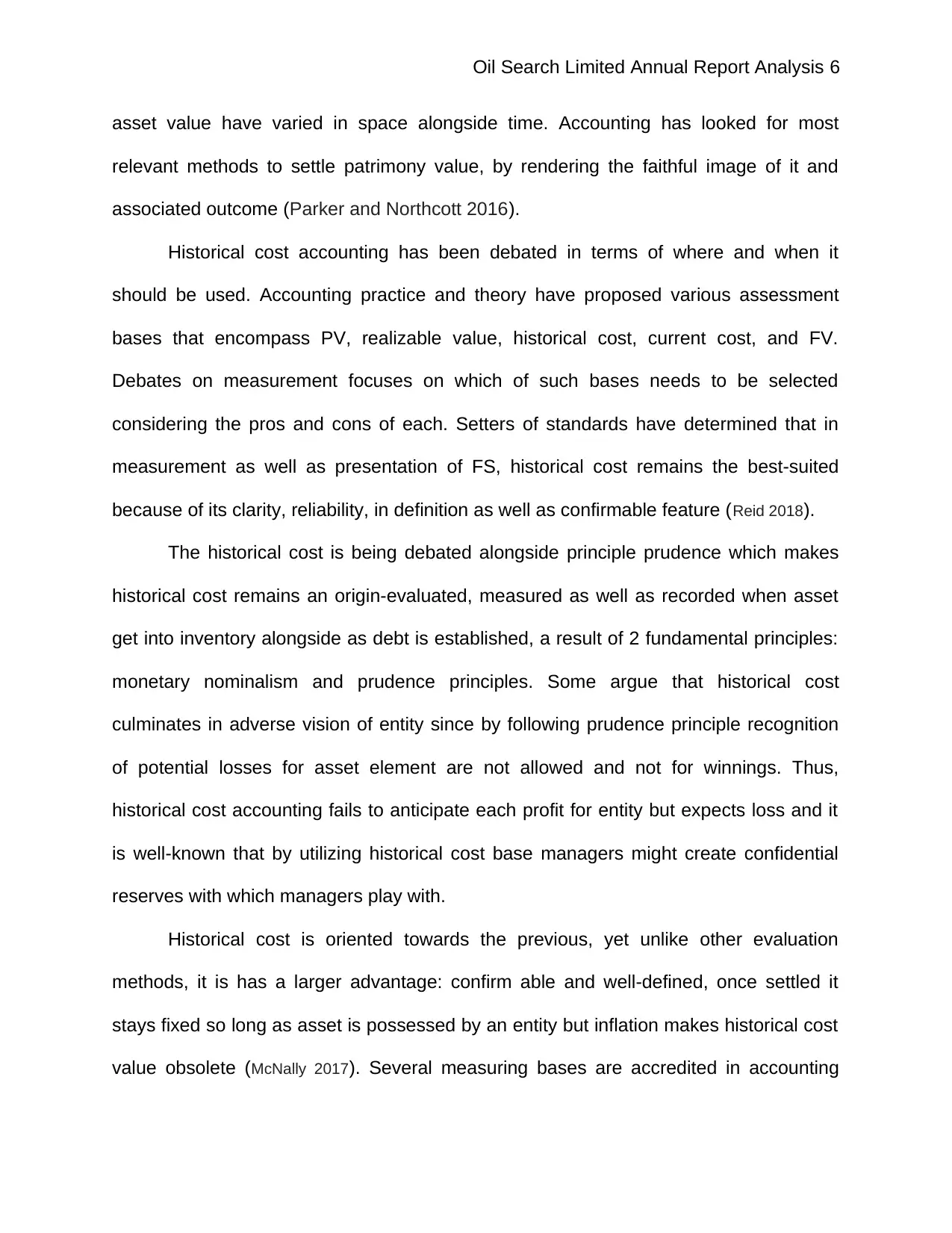
Oil Search Limited Annual Report Analysis 6
asset value have varied in space alongside time. Accounting has looked for most
relevant methods to settle patrimony value, by rendering the faithful image of it and
associated outcome (Parker and Northcott 2016).
Historical cost accounting has been debated in terms of where and when it
should be used. Accounting practice and theory have proposed various assessment
bases that encompass PV, realizable value, historical cost, current cost, and FV.
Debates on measurement focuses on which of such bases needs to be selected
considering the pros and cons of each. Setters of standards have determined that in
measurement as well as presentation of FS, historical cost remains the best-suited
because of its clarity, reliability, in definition as well as confirmable feature (Reid 2018).
The historical cost is being debated alongside principle prudence which makes
historical cost remains an origin-evaluated, measured as well as recorded when asset
get into inventory alongside as debt is established, a result of 2 fundamental principles:
monetary nominalism and prudence principles. Some argue that historical cost
culminates in adverse vision of entity since by following prudence principle recognition
of potential losses for asset element are not allowed and not for winnings. Thus,
historical cost accounting fails to anticipate each profit for entity but expects loss and it
is well-known that by utilizing historical cost base managers might create confidential
reserves with which managers play with.
Historical cost is oriented towards the previous, yet unlike other evaluation
methods, it is has a larger advantage: confirm able and well-defined, once settled it
stays fixed so long as asset is possessed by an entity but inflation makes historical cost
value obsolete (McNally 2017). Several measuring bases are accredited in accounting
asset value have varied in space alongside time. Accounting has looked for most
relevant methods to settle patrimony value, by rendering the faithful image of it and
associated outcome (Parker and Northcott 2016).
Historical cost accounting has been debated in terms of where and when it
should be used. Accounting practice and theory have proposed various assessment
bases that encompass PV, realizable value, historical cost, current cost, and FV.
Debates on measurement focuses on which of such bases needs to be selected
considering the pros and cons of each. Setters of standards have determined that in
measurement as well as presentation of FS, historical cost remains the best-suited
because of its clarity, reliability, in definition as well as confirmable feature (Reid 2018).
The historical cost is being debated alongside principle prudence which makes
historical cost remains an origin-evaluated, measured as well as recorded when asset
get into inventory alongside as debt is established, a result of 2 fundamental principles:
monetary nominalism and prudence principles. Some argue that historical cost
culminates in adverse vision of entity since by following prudence principle recognition
of potential losses for asset element are not allowed and not for winnings. Thus,
historical cost accounting fails to anticipate each profit for entity but expects loss and it
is well-known that by utilizing historical cost base managers might create confidential
reserves with which managers play with.
Historical cost is oriented towards the previous, yet unlike other evaluation
methods, it is has a larger advantage: confirm able and well-defined, once settled it
stays fixed so long as asset is possessed by an entity but inflation makes historical cost
value obsolete (McNally 2017). Several measuring bases are accredited in accounting
⊘ This is a preview!⊘
Do you want full access?
Subscribe today to unlock all pages.

Trusted by 1+ million students worldwide
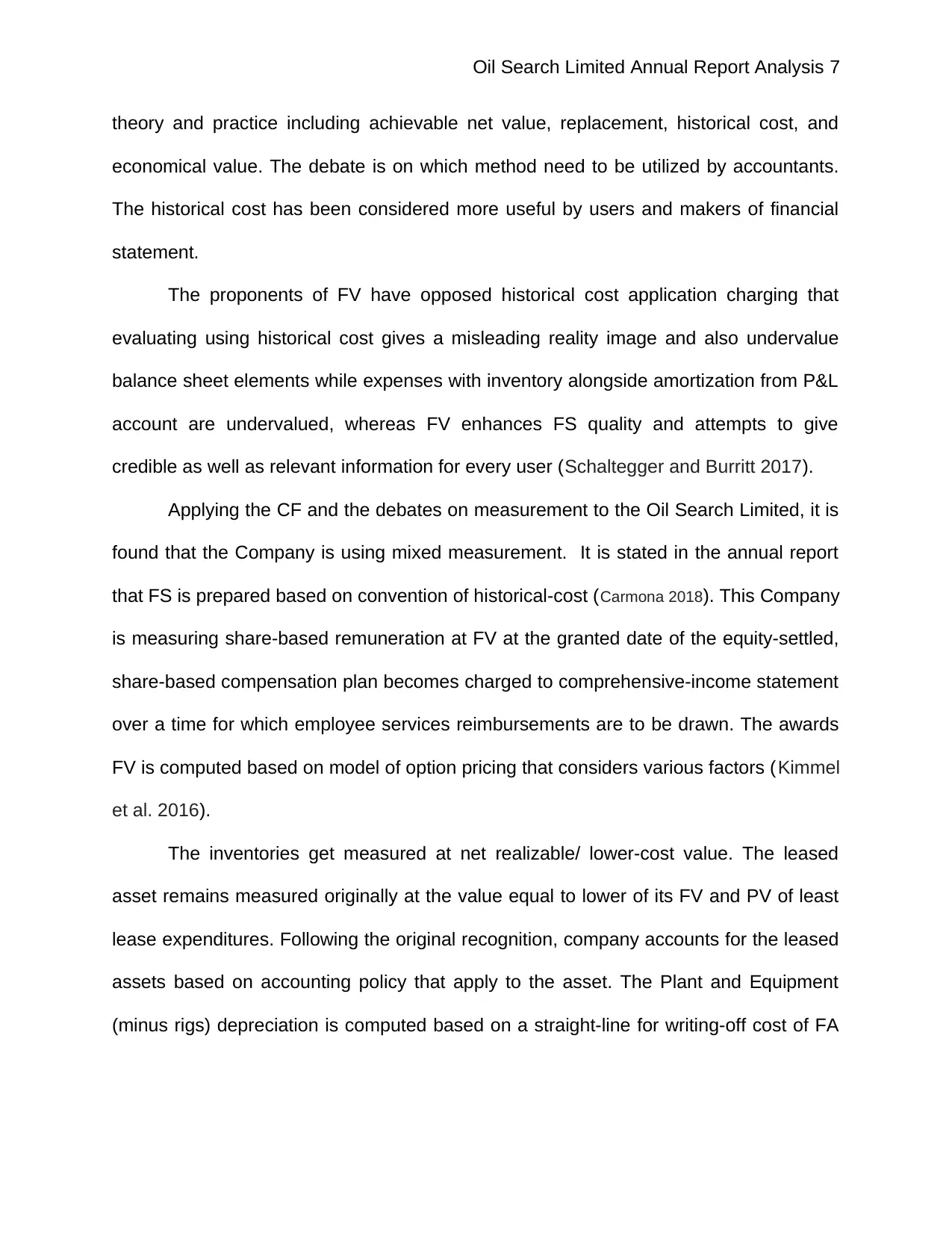
Oil Search Limited Annual Report Analysis 7
theory and practice including achievable net value, replacement, historical cost, and
economical value. The debate is on which method need to be utilized by accountants.
The historical cost has been considered more useful by users and makers of financial
statement.
The proponents of FV have opposed historical cost application charging that
evaluating using historical cost gives a misleading reality image and also undervalue
balance sheet elements while expenses with inventory alongside amortization from P&L
account are undervalued, whereas FV enhances FS quality and attempts to give
credible as well as relevant information for every user (Schaltegger and Burritt 2017).
Applying the CF and the debates on measurement to the Oil Search Limited, it is
found that the Company is using mixed measurement. It is stated in the annual report
that FS is prepared based on convention of historical-cost (Carmona 2018). This Company
is measuring share-based remuneration at FV at the granted date of the equity-settled,
share-based compensation plan becomes charged to comprehensive-income statement
over a time for which employee services reimbursements are to be drawn. The awards
FV is computed based on model of option pricing that considers various factors (Kimmel
et al. 2016).
The inventories get measured at net realizable/ lower-cost value. The leased
asset remains measured originally at the value equal to lower of its FV and PV of least
lease expenditures. Following the original recognition, company accounts for the leased
assets based on accounting policy that apply to the asset. The Plant and Equipment
(minus rigs) depreciation is computed based on a straight-line for writing-off cost of FA
theory and practice including achievable net value, replacement, historical cost, and
economical value. The debate is on which method need to be utilized by accountants.
The historical cost has been considered more useful by users and makers of financial
statement.
The proponents of FV have opposed historical cost application charging that
evaluating using historical cost gives a misleading reality image and also undervalue
balance sheet elements while expenses with inventory alongside amortization from P&L
account are undervalued, whereas FV enhances FS quality and attempts to give
credible as well as relevant information for every user (Schaltegger and Burritt 2017).
Applying the CF and the debates on measurement to the Oil Search Limited, it is
found that the Company is using mixed measurement. It is stated in the annual report
that FS is prepared based on convention of historical-cost (Carmona 2018). This Company
is measuring share-based remuneration at FV at the granted date of the equity-settled,
share-based compensation plan becomes charged to comprehensive-income statement
over a time for which employee services reimbursements are to be drawn. The awards
FV is computed based on model of option pricing that considers various factors (Kimmel
et al. 2016).
The inventories get measured at net realizable/ lower-cost value. The leased
asset remains measured originally at the value equal to lower of its FV and PV of least
lease expenditures. Following the original recognition, company accounts for the leased
assets based on accounting policy that apply to the asset. The Plant and Equipment
(minus rigs) depreciation is computed based on a straight-line for writing-off cost of FA
Paraphrase This Document
Need a fresh take? Get an instant paraphrase of this document with our AI Paraphraser
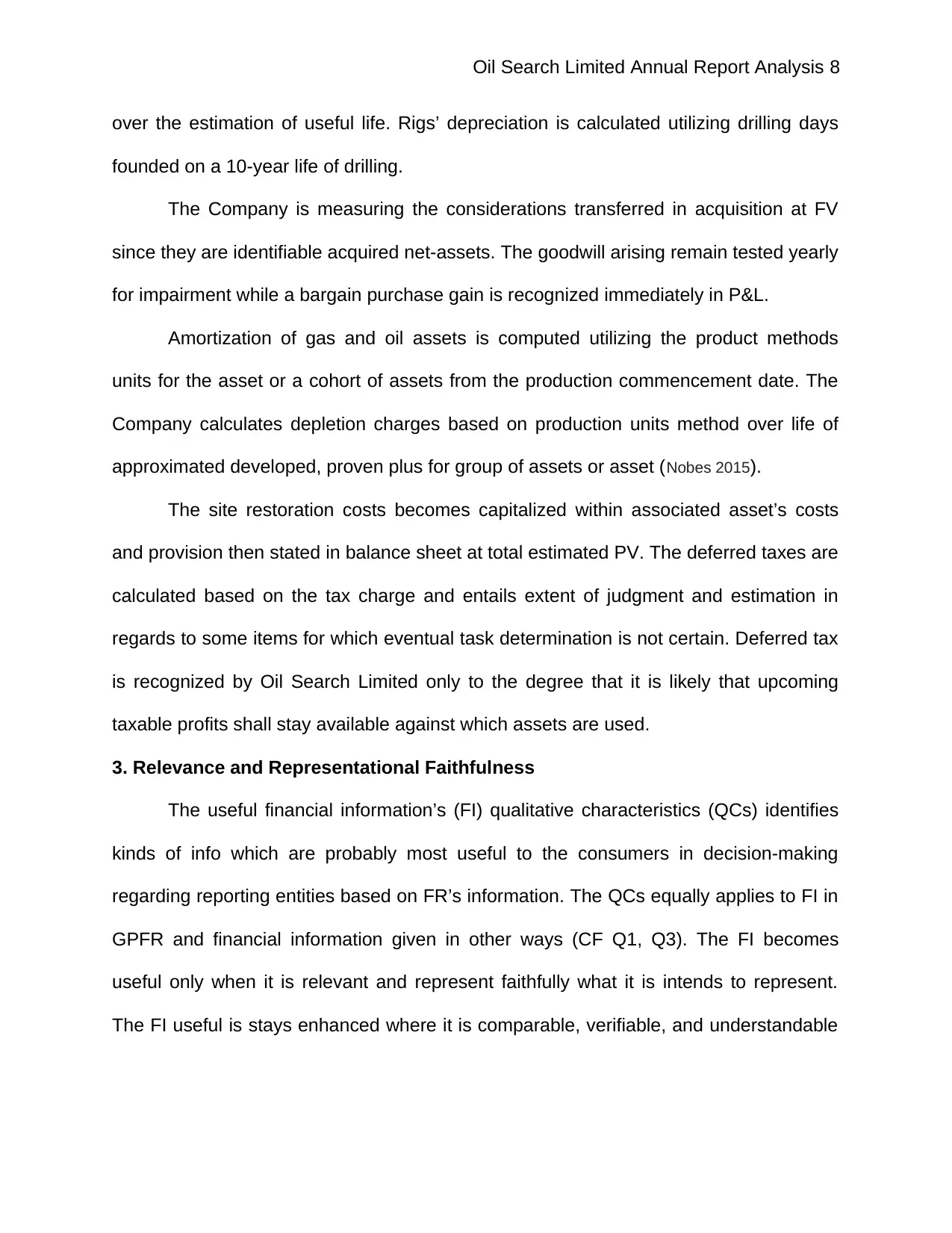
Oil Search Limited Annual Report Analysis 8
over the estimation of useful life. Rigs’ depreciation is calculated utilizing drilling days
founded on a 10-year life of drilling.
The Company is measuring the considerations transferred in acquisition at FV
since they are identifiable acquired net-assets. The goodwill arising remain tested yearly
for impairment while a bargain purchase gain is recognized immediately in P&L.
Amortization of gas and oil assets is computed utilizing the product methods
units for the asset or a cohort of assets from the production commencement date. The
Company calculates depletion charges based on production units method over life of
approximated developed, proven plus for group of assets or asset (Nobes 2015).
The site restoration costs becomes capitalized within associated asset’s costs
and provision then stated in balance sheet at total estimated PV. The deferred taxes are
calculated based on the tax charge and entails extent of judgment and estimation in
regards to some items for which eventual task determination is not certain. Deferred tax
is recognized by Oil Search Limited only to the degree that it is likely that upcoming
taxable profits shall stay available against which assets are used.
3. Relevance and Representational Faithfulness
The useful financial information’s (FI) qualitative characteristics (QCs) identifies
kinds of info which are probably most useful to the consumers in decision-making
regarding reporting entities based on FR’s information. The QCs equally applies to FI in
GPFR and financial information given in other ways (CF Q1, Q3). The FI becomes
useful only when it is relevant and represent faithfully what it is intends to represent.
The FI useful is stays enhanced where it is comparable, verifiable, and understandable
over the estimation of useful life. Rigs’ depreciation is calculated utilizing drilling days
founded on a 10-year life of drilling.
The Company is measuring the considerations transferred in acquisition at FV
since they are identifiable acquired net-assets. The goodwill arising remain tested yearly
for impairment while a bargain purchase gain is recognized immediately in P&L.
Amortization of gas and oil assets is computed utilizing the product methods
units for the asset or a cohort of assets from the production commencement date. The
Company calculates depletion charges based on production units method over life of
approximated developed, proven plus for group of assets or asset (Nobes 2015).
The site restoration costs becomes capitalized within associated asset’s costs
and provision then stated in balance sheet at total estimated PV. The deferred taxes are
calculated based on the tax charge and entails extent of judgment and estimation in
regards to some items for which eventual task determination is not certain. Deferred tax
is recognized by Oil Search Limited only to the degree that it is likely that upcoming
taxable profits shall stay available against which assets are used.
3. Relevance and Representational Faithfulness
The useful financial information’s (FI) qualitative characteristics (QCs) identifies
kinds of info which are probably most useful to the consumers in decision-making
regarding reporting entities based on FR’s information. The QCs equally applies to FI in
GPFR and financial information given in other ways (CF Q1, Q3). The FI becomes
useful only when it is relevant and represent faithfully what it is intends to represent.
The FI useful is stays enhanced where it is comparable, verifiable, and understandable

Oil Search Limited Annual Report Analysis 9
and timely (CF QC4). The fundamental QCs of useful FI are the relevance besides
faithful representation (CF QC5).
Relevance
In regards to relevance, a relevant FI has the capability of making a distinction in
decision that users make. The FI is can make a variation in decision-making only if it
has the predictive-, confirmatory-value or even both. The predictive value as well as
confirmatory value of FS remain interlinked (CF QC6-Q10). The entity-specific
relevance aspect is materiality which is anchored on magnitude or nature (or the two) of
items to which an information relates in a specific entity’s FR (CF Q11). Relevance can
be illustrated considering the decision concerning the replacement of an equipment
which has been utilized for previous six years. In this case, the initial equipment cost
has no relevance. This implies that the initial cost remains irrelevant or is never relevant
in deciding to replace equipment. What is relevance is upcoming amounts like new
equipment cost, and the saving occurring with replacement of old equipment.
Alternatively, relevance is illustrated using cost which will vary among the options. Such
cost lacks relevance Vyas, Ambadkar and Bhargavaϯ 2015 (). Thus, a financial information
has to remain timely if they are timely. FS issued 3 weeks following accounting period
closure has more relevance than FS issued many months following the period end.
Timeliness as well as relevance might imply sacrificing certain reliability and precision
(Cascino et al. 2017). The nature alongside materiality of an information affects its
relevance. Materiality is attained where if an information is omitted, or misstated,
influences users’ decisions based on financial information regarding a reporting entity
and timely (CF QC4). The fundamental QCs of useful FI are the relevance besides
faithful representation (CF QC5).
Relevance
In regards to relevance, a relevant FI has the capability of making a distinction in
decision that users make. The FI is can make a variation in decision-making only if it
has the predictive-, confirmatory-value or even both. The predictive value as well as
confirmatory value of FS remain interlinked (CF QC6-Q10). The entity-specific
relevance aspect is materiality which is anchored on magnitude or nature (or the two) of
items to which an information relates in a specific entity’s FR (CF Q11). Relevance can
be illustrated considering the decision concerning the replacement of an equipment
which has been utilized for previous six years. In this case, the initial equipment cost
has no relevance. This implies that the initial cost remains irrelevant or is never relevant
in deciding to replace equipment. What is relevance is upcoming amounts like new
equipment cost, and the saving occurring with replacement of old equipment.
Alternatively, relevance is illustrated using cost which will vary among the options. Such
cost lacks relevance Vyas, Ambadkar and Bhargavaϯ 2015 (). Thus, a financial information
has to remain timely if they are timely. FS issued 3 weeks following accounting period
closure has more relevance than FS issued many months following the period end.
Timeliness as well as relevance might imply sacrificing certain reliability and precision
(Cascino et al. 2017). The nature alongside materiality of an information affects its
relevance. Materiality is attained where if an information is omitted, or misstated,
influences users’ decisions based on financial information regarding a reporting entity
⊘ This is a preview!⊘
Do you want full access?
Subscribe today to unlock all pages.

Trusted by 1+ million students worldwide

Oil Search Limited Annual Report Analysis 10
(McInnis, Yu and Yust 2018). It is relevance aspect which remains entity-specific. A
materiality to one entity might be immaterial to another.
Faithful Representation
The GPFR represent an economic phenomenon in figures as well as words. For
a financial information (FI) to stay useful, it must be relevant as well as faithfully
represent the phenomenon it is claiming to characterize. Such a fundamental
characteristics aims at maximizing fundamental characteristics of freedom, neutrality,
alongside completeness from error (CF QC12). The FI is only useful when it remains
relevant as well as faithfully represented (CF QC17).
Relevance alongside faithful representation remain fundamental quality
characteristics of FI that has to exist for the information to be useful. They contain equal
weight in terms of importance in accounting for assets and liabilities. Thus, neither
relevance nor representation faithfully is inferior or superior to each other when
accounting for liabilities and assets (Gao and Wang 2017).
Faithful representation is influenced by three features including completeness,
neutrality, and free from error (Palea 2015). Completeness encompass display of all
essential information for users to comprehend displayed phenomenon (Birt, Muthusamy
and Bir 2017). It entails all essential explanations and description or sufficient of full
disclosure of every information as seen in Oil Search Limited. Neutrality implies that
manifestation is not bias in presentation or selection of FS. This means that FS must
never be manipulated to influence users’ decisions achieved through fairness as well as
freedom from bias. The FS must be true and fair. Free from error implies no error as
(McInnis, Yu and Yust 2018). It is relevance aspect which remains entity-specific. A
materiality to one entity might be immaterial to another.
Faithful Representation
The GPFR represent an economic phenomenon in figures as well as words. For
a financial information (FI) to stay useful, it must be relevant as well as faithfully
represent the phenomenon it is claiming to characterize. Such a fundamental
characteristics aims at maximizing fundamental characteristics of freedom, neutrality,
alongside completeness from error (CF QC12). The FI is only useful when it remains
relevant as well as faithfully represented (CF QC17).
Relevance alongside faithful representation remain fundamental quality
characteristics of FI that has to exist for the information to be useful. They contain equal
weight in terms of importance in accounting for assets and liabilities. Thus, neither
relevance nor representation faithfully is inferior or superior to each other when
accounting for liabilities and assets (Gao and Wang 2017).
Faithful representation is influenced by three features including completeness,
neutrality, and free from error (Palea 2015). Completeness encompass display of all
essential information for users to comprehend displayed phenomenon (Birt, Muthusamy
and Bir 2017). It entails all essential explanations and description or sufficient of full
disclosure of every information as seen in Oil Search Limited. Neutrality implies that
manifestation is not bias in presentation or selection of FS. This means that FS must
never be manipulated to influence users’ decisions achieved through fairness as well as
freedom from bias. The FS must be true and fair. Free from error implies no error as
Paraphrase This Document
Need a fresh take? Get an instant paraphrase of this document with our AI Paraphraser

Oil Search Limited Annual Report Analysis 11
well as inaccuracies in phenomenon description and no errors made when preparing
FS. It is achieved by no omissions or inaccuracies in FR through a realistic basis.
Conclusion
The analysis of Oil Search Limited has revealed that the Company is using
various accounting concepts and mixed measurement approaches in its FS. The
discussion has also captured the relevance and faithful representation of the Company.
It is concluded that the company is engaged in full disclosure and values provision of
useful FS to its users to inform their decisions.
well as inaccuracies in phenomenon description and no errors made when preparing
FS. It is achieved by no omissions or inaccuracies in FR through a realistic basis.
Conclusion
The analysis of Oil Search Limited has revealed that the Company is using
various accounting concepts and mixed measurement approaches in its FS. The
discussion has also captured the relevance and faithful representation of the Company.
It is concluded that the company is engaged in full disclosure and values provision of
useful FS to its users to inform their decisions.
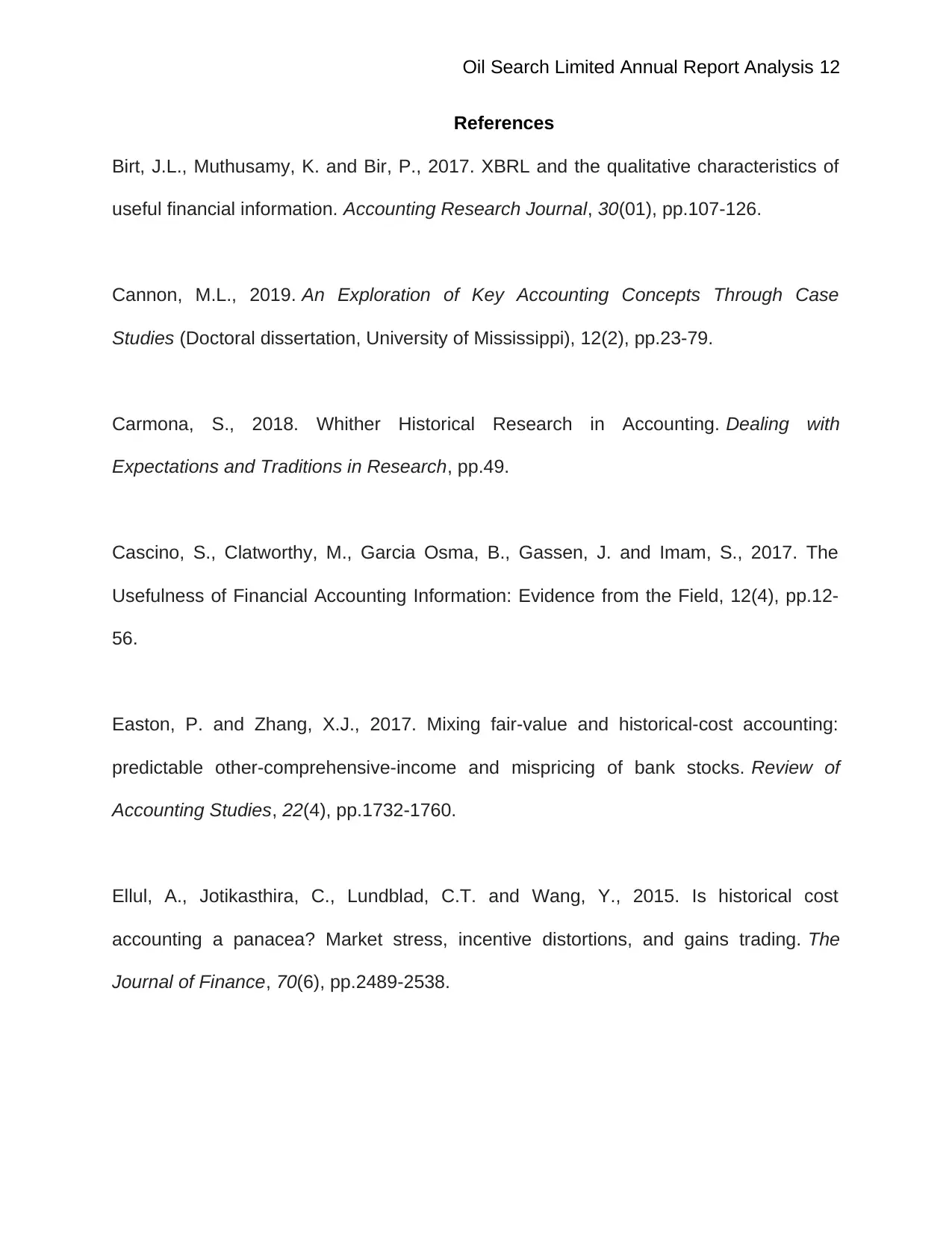
Oil Search Limited Annual Report Analysis 12
References
Birt, J.L., Muthusamy, K. and Bir, P., 2017. XBRL and the qualitative characteristics of
useful financial information. Accounting Research Journal, 30(01), pp.107-126.
Cannon, M.L., 2019. An Exploration of Key Accounting Concepts Through Case
Studies (Doctoral dissertation, University of Mississippi), 12(2), pp.23-79.
Carmona, S., 2018. Whither Historical Research in Accounting. Dealing with
Expectations and Traditions in Research, pp.49.
Cascino, S., Clatworthy, M., Garcia Osma, B., Gassen, J. and Imam, S., 2017. The
Usefulness of Financial Accounting Information: Evidence from the Field, 12(4), pp.12-
56.
Easton, P. and Zhang, X.J., 2017. Mixing fair-value and historical-cost accounting:
predictable other-comprehensive-income and mispricing of bank stocks. Review of
Accounting Studies, 22(4), pp.1732-1760.
Ellul, A., Jotikasthira, C., Lundblad, C.T. and Wang, Y., 2015. Is historical cost
accounting a panacea? Market stress, incentive distortions, and gains trading. The
Journal of Finance, 70(6), pp.2489-2538.
References
Birt, J.L., Muthusamy, K. and Bir, P., 2017. XBRL and the qualitative characteristics of
useful financial information. Accounting Research Journal, 30(01), pp.107-126.
Cannon, M.L., 2019. An Exploration of Key Accounting Concepts Through Case
Studies (Doctoral dissertation, University of Mississippi), 12(2), pp.23-79.
Carmona, S., 2018. Whither Historical Research in Accounting. Dealing with
Expectations and Traditions in Research, pp.49.
Cascino, S., Clatworthy, M., Garcia Osma, B., Gassen, J. and Imam, S., 2017. The
Usefulness of Financial Accounting Information: Evidence from the Field, 12(4), pp.12-
56.
Easton, P. and Zhang, X.J., 2017. Mixing fair-value and historical-cost accounting:
predictable other-comprehensive-income and mispricing of bank stocks. Review of
Accounting Studies, 22(4), pp.1732-1760.
Ellul, A., Jotikasthira, C., Lundblad, C.T. and Wang, Y., 2015. Is historical cost
accounting a panacea? Market stress, incentive distortions, and gains trading. The
Journal of Finance, 70(6), pp.2489-2538.
⊘ This is a preview!⊘
Do you want full access?
Subscribe today to unlock all pages.

Trusted by 1+ million students worldwide
1 out of 15
Related Documents
Your All-in-One AI-Powered Toolkit for Academic Success.
+13062052269
info@desklib.com
Available 24*7 on WhatsApp / Email
![[object Object]](/_next/static/media/star-bottom.7253800d.svg)
Unlock your academic potential
Copyright © 2020–2026 A2Z Services. All Rights Reserved. Developed and managed by ZUCOL.





